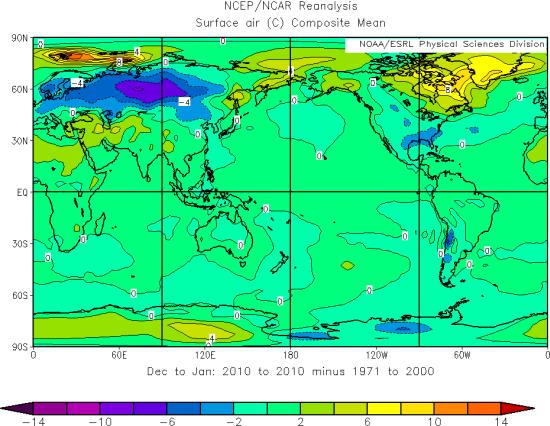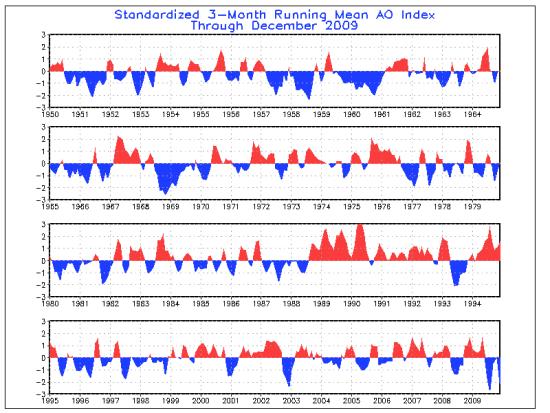Climate change queries (1) - mini ice age ?
12 February 2010
The furious snowstorms that battered much of the mid-latitude region of the Northern Hemisphere in December 2009 and January 2010 have drawn much attention from the media. Bundled with the report of an increase in Arctic sea ice since 2007 and some research discussions on the decadal variations in climate, a new phrase "mini ice age" emerge from an overseas news article and was widely reported in the local media, raising queries about the credibility of 'global warming'. I shall attempt to answer these queries.
What is a 'mini ice age' ?
The term 'ice age' generally refers to a long period of time (millions of years) during which extensive ice sheets (glaciers) formed over many parts of the world. Another term, 'little ice age', has also been used to describe a modest cooling of the Northern Hemisphere roughly from the 14th to 19th century, but this was not exactly a 'ice age' as it was not cold enough and long enough to cause extensive ice sheet cover. The recent cold spell in late 2009 and early 2010 is even shorter, not to mention the limited ice cover, and the use of 'ice age' to describe it is clearly inappropriate.
The name 'mini ice age' came from a U.K. newspaper published on 10 January and did not appear in either the paper or the speech of the relevant researcher. Indeed, the researcher merely pointed out (on the Internet) that the present cooling "may offset global warming for a decade" and "there is quite some uncertainty about the short-term evolution [of global warming]". Further, he said "we all agree that in the long run, say by 2050 and thereafter the earth will considerably warm, if we do not considerably reduce global greenhouse gas emission."
At this point, it should be clear that the cold spell occurring in late 2009 and early 2010 is 'weather' and has nothing to do with the 'climate'. Climate refers to a period of at least 30 years according to the World Meteorological Organization (WMO).
What about the weather elsewhere and the cold weather in Hong Kong ?
The recent cold weather affected mainly Europe, Eurasia, northern part of China, and North America. Elsewhere, temperatures of some places in the Arctic were warmer than the normal by 10 oC or more. The tropics in the Northern Hemisphere and large areas in the Southern Hemisphere had above normal temperatures. Temperatures in southern Australia recently went above 40 oC. Locally in Hong Kong, although we had the earliest cold weather warning issued in November 2009 and December 2009 was cooler than normal, the weather as a whole was exceptionally warm for 2009 which ranks the 9th warmest year since records began in 1884. Despite the issuance of cold weather warnings in January 2010, the monthly mean temperature of 16.8 oC is 0.7 oC above normal. The recent cold weather in some regions of the Northern Hemisphere should be considered as part of the normal short-term variations in the weather.

Figure 1Global surface temperature anomaly (difference from 1971-2000 average)
for the period from December 2009 to January 2010
(Image provided by the NOAA/OAR/ESRL PSD, Boulder, Colorado,
USA, from their Web site at http://www.esrl.noaa.gov/psd/)
What are the causes of the cold weather ?
Various factors could contribute to the cold weather in late 2009 and early 2010. According to some scientists, one of the possible causes is the Arctic Oscillation's strong negative phase during the period. In short, the Arctic Oscillation (AO) refers to variations in the difference in the atmospheric pressure in northern mid-latitudes (about 45 degrees North) and the Arctic. In the negative phase, weather patterns in the Northern Hemisphere are more favourable for the outbreaks of frigid air from the Arctic. Patterns in the positive phase are in general opposite to those of the negative phase, somehow restricting the cold Arctic air from spreading south. Information about the AO over the past six decades (Figure 2) suggests that there is nothing very unusual for the year 2009.

Figure 23-month running mean of Arctic Oscillation Index from 1950 to 2009
(Source : Climate Predication Center, NOAA)
How do we interpret all these wild fluctuations in weather ?
Snowstorms and very cold weather are extreme events. However, such events are part of variable natural climate. The United Nations IPCC (Intergovernment Panel on Climate Change) pointed out in 2007 that temperatures are rising in the long term and that as a result of global warming, extremely cold events have become less frequent over the past few decades. These events are expected to decrease further as global temperatures continue to rise.
For Hong Kong, one thing that comes to my mind is that in January/February 2008 we had, for the first time in over 40 years, 24 days in a row having temperatures falling to 12 oC or below, while in 2009 we had the warmest February since records began in 1884. 6 out of the 10 warmest February in Hong Kong occurred after 1990. While we still cannot say with certainty that each of these extreme events is related to climate change, the wild swing in hot and cold surely gives us a flavour of what climate change may bring in the long run.
B.Y. Lee
What is a 'mini ice age' ?
The term 'ice age' generally refers to a long period of time (millions of years) during which extensive ice sheets (glaciers) formed over many parts of the world. Another term, 'little ice age', has also been used to describe a modest cooling of the Northern Hemisphere roughly from the 14th to 19th century, but this was not exactly a 'ice age' as it was not cold enough and long enough to cause extensive ice sheet cover. The recent cold spell in late 2009 and early 2010 is even shorter, not to mention the limited ice cover, and the use of 'ice age' to describe it is clearly inappropriate.
The name 'mini ice age' came from a U.K. newspaper published on 10 January and did not appear in either the paper or the speech of the relevant researcher. Indeed, the researcher merely pointed out (on the Internet) that the present cooling "may offset global warming for a decade" and "there is quite some uncertainty about the short-term evolution [of global warming]". Further, he said "we all agree that in the long run, say by 2050 and thereafter the earth will considerably warm, if we do not considerably reduce global greenhouse gas emission."
At this point, it should be clear that the cold spell occurring in late 2009 and early 2010 is 'weather' and has nothing to do with the 'climate'. Climate refers to a period of at least 30 years according to the World Meteorological Organization (WMO).
What about the weather elsewhere and the cold weather in Hong Kong ?
The recent cold weather affected mainly Europe, Eurasia, northern part of China, and North America. Elsewhere, temperatures of some places in the Arctic were warmer than the normal by 10 oC or more. The tropics in the Northern Hemisphere and large areas in the Southern Hemisphere had above normal temperatures. Temperatures in southern Australia recently went above 40 oC. Locally in Hong Kong, although we had the earliest cold weather warning issued in November 2009 and December 2009 was cooler than normal, the weather as a whole was exceptionally warm for 2009 which ranks the 9th warmest year since records began in 1884. Despite the issuance of cold weather warnings in January 2010, the monthly mean temperature of 16.8 oC is 0.7 oC above normal. The recent cold weather in some regions of the Northern Hemisphere should be considered as part of the normal short-term variations in the weather.

Figure 1Global surface temperature anomaly (difference from 1971-2000 average)
for the period from December 2009 to January 2010
(Image provided by the NOAA/OAR/ESRL PSD, Boulder, Colorado,
USA, from their Web site at http://www.esrl.noaa.gov/psd/)
What are the causes of the cold weather ?
Various factors could contribute to the cold weather in late 2009 and early 2010. According to some scientists, one of the possible causes is the Arctic Oscillation's strong negative phase during the period. In short, the Arctic Oscillation (AO) refers to variations in the difference in the atmospheric pressure in northern mid-latitudes (about 45 degrees North) and the Arctic. In the negative phase, weather patterns in the Northern Hemisphere are more favourable for the outbreaks of frigid air from the Arctic. Patterns in the positive phase are in general opposite to those of the negative phase, somehow restricting the cold Arctic air from spreading south. Information about the AO over the past six decades (Figure 2) suggests that there is nothing very unusual for the year 2009.

Figure 23-month running mean of Arctic Oscillation Index from 1950 to 2009
(Source : Climate Predication Center, NOAA)
How do we interpret all these wild fluctuations in weather ?
Snowstorms and very cold weather are extreme events. However, such events are part of variable natural climate. The United Nations IPCC (Intergovernment Panel on Climate Change) pointed out in 2007 that temperatures are rising in the long term and that as a result of global warming, extremely cold events have become less frequent over the past few decades. These events are expected to decrease further as global temperatures continue to rise.
For Hong Kong, one thing that comes to my mind is that in January/February 2008 we had, for the first time in over 40 years, 24 days in a row having temperatures falling to 12 oC or below, while in 2009 we had the warmest February since records began in 1884. 6 out of the 10 warmest February in Hong Kong occurred after 1990. While we still cannot say with certainty that each of these extreme events is related to climate change, the wild swing in hot and cold surely gives us a flavour of what climate change may bring in the long run.
B.Y. Lee